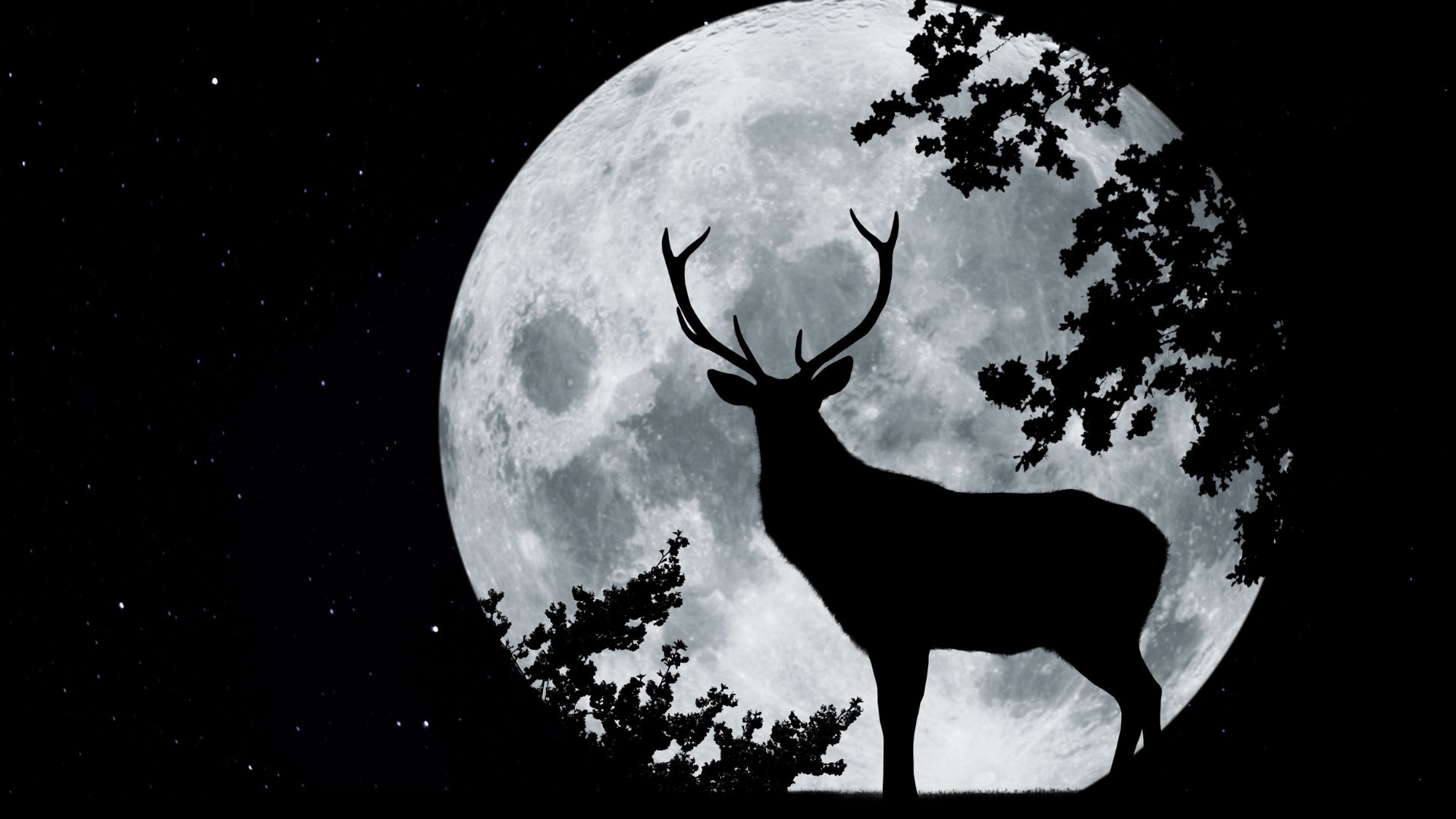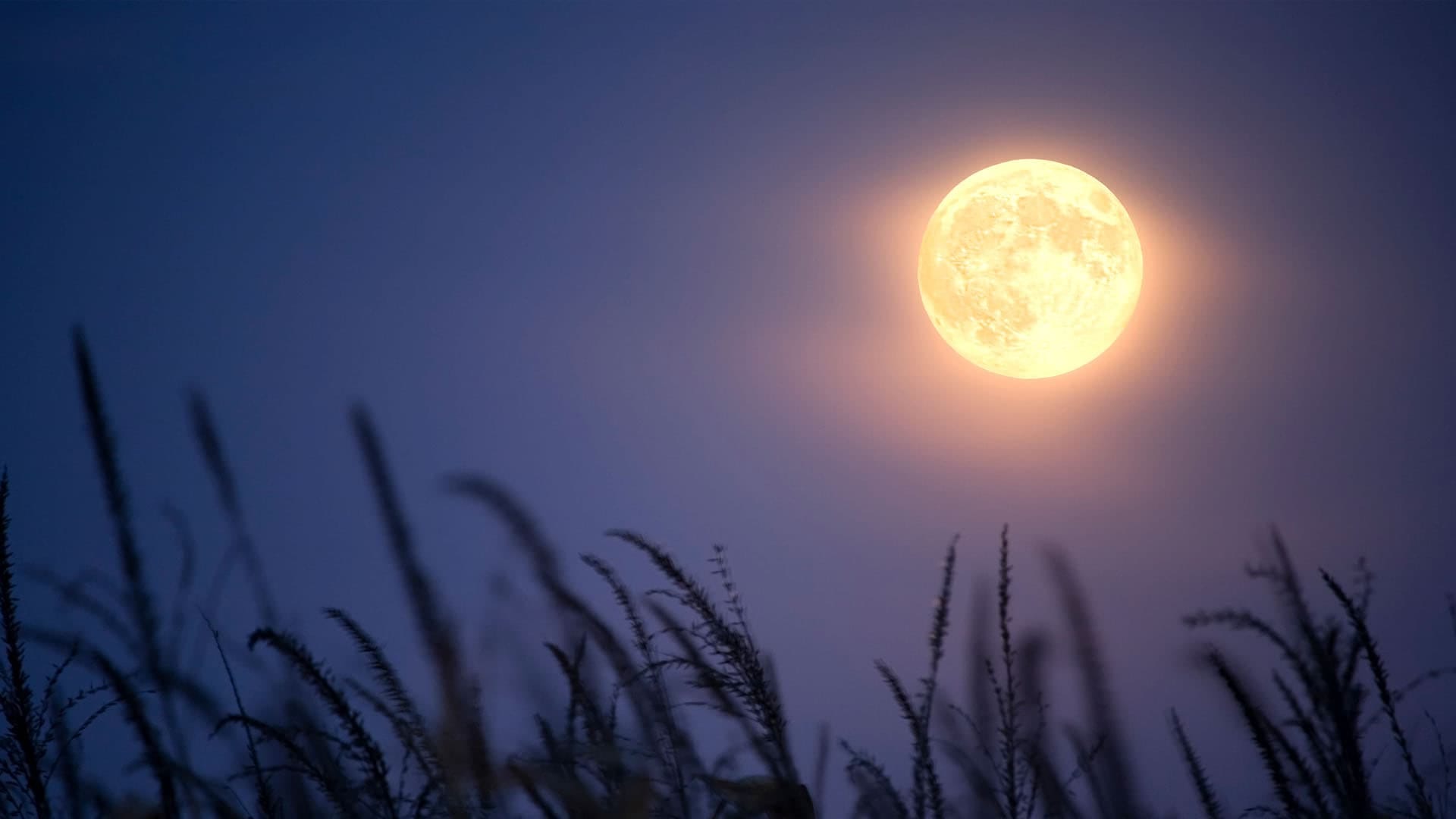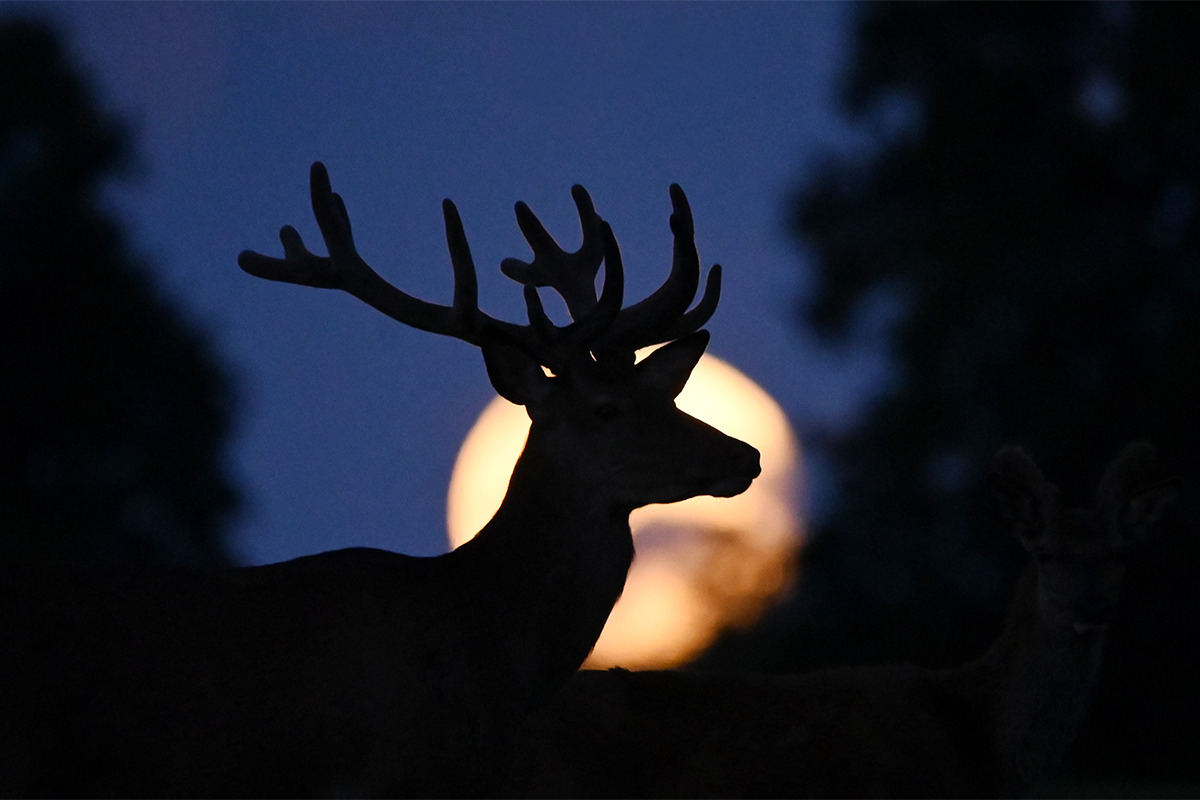What Is A Full Buck Moon - How To See It, Spiritual Meaning, And More
The "Full Buck Moon" is the nickname for the full moon that occurs in July. It's named after the season when new antlers of buck deer, or male deer, grow larger and more visible.
Author:Michele SievertReviewer:Georgia AshcroftOct 27, 2023137 Shares68.6K Views

The Full Buck Moon, a captivating celestial phenomenon, captures the imagination with its mystique and allure. This lunar event has significant cultural meaning and astronomical importance, and it is named after the magnificent male deer, the buck. The full moon represents a crucial point in the lunar cycle when the Earth, moon, and sun align in a dance of the cosmos.
Beyond its astronomical marvel, the Full Buck Moon has long-standing cultural significance. Native American tribes utilized this moon event to signal significant seasonal changes and direct their hunting and farming operations.
The Full Buck Moon still resonates today, fusing traditional legend with contemporary intrigue. Its brightness entices spectators to turn their heads upward and make a connection with both the past and the universe. In this article, we dig into the enthralling narrative of the Full Buck Moon and explore the many layers of importance that have contributed to its continuing fame as a celestial wonder.
What Is A Buck Moon?
The full moon that appears in July is known as the Buck Moon. Traditions practiced by Indigenous Americans, particularly those of the Algonquin tribes, for the purpose of charting the changing of the seasons, have given each of the 13 full moons their names. These names served to remind people of what to anticipate from the present season and how to plan for the future.
The month of July, when bucks' (male deer) antlers are at their largest before they lose them and begin the process of developing new antlers all over again, is how the full moon known as the Buck Moon received its name. This is the moniker that is most often used to refer to the full moon that occurs in the month of July in North America; nevertheless, it is also known as the Thunder Moon, the Salmon Moon, the Herb Moon, and the Mead Moon.
All of these names refer to natural phenomena that take place during the month of July, such as the increased likelihood of thunderstorms, the profusion of wild berries, and the return of salmon after they have finished spawning.
In addition to serving a practical purpose, the Buck Moon was also significant from a religious and cultural perspective. Different groups of people, each with their own set of beliefs and experiences in the area, gave this moon a name that was unique to them. The indigenous people's relationship to the land, the passage of time, and their position in the universe often served as the inspiration for these names.
As a result, the Buck Moon reflects the union of human interpretation and the wonders of the cosmos, making it a symbol of the complex interaction that exists between culture and the natural world.
Symbolic Meanings And Interpretations Associated With The Full Buck Moon
A connection between the Full Buck Moon and the natural cycles of life, which may entail both death and rebirth, has existed since ancient times. As a result of where in the sky it is located at this time of year, a full moon at this time of year is connected with abundance and fertility.
Life is a series of ebbs and flows similar to the way the ocean recedes and experiences high tide—the way it rushes forward forcefully against beaches and sometimes stays so peaceful that you can hardly hear it. These ebbs and flows are comparable to the way the ocean recedes and experiences high tide.
To put it another way, life is comparable to the sea. Many people are aware of the relationship that exists between the phases of the moon and the tides of the ocean; hence, they consider the Buck Moon as yet another example of the cycles that take place in life.
During this period, the Full buck moon will act as a continual reminder of the changes that are inevitably taking place in your life. These changes are unavoidable. It is time for you to let go of your hard, rational understanding and instead delve into your heart to allow it to lead you into the next chapter of your life. It is time for you to let go of your rigid, logical understanding.
At this juncture, it is important for you to take it easy, mull things over, and check in with your feelings as you doso. As the new reality becomes more apparent, now is the time to slow down, reevaluate the order in which things are most important to you, and provide every facet of your existence with the chance to rest and recharge.
It's conceivable that you've already started seeing changes in one of the structures in your life, such as your family, your job, or even your friendships, or that you're going to start noticing them. For example, it's possible that you've already started noticing changes in your family. Lean into the center of the change that is taking place in your life and enthusiastically embrace the new chapter it is ushering in.
The Astronomical Science Behind The Full Moon
The Full Buck's inspiration came from the hypnotic motion of the heavenly bodies. The complex interactions between the Earth, moon, and sun led to the formation of the moon. This phenomenon's underlying astronomical science reveals the splendor of our little universe.
Lunar Cycle And Full Moon Occurrence
The moon goes through a cyclical series of phases, during which its appearance changes. It starts with the new moon when the moon lies between the earth and the sun and has light shining on its far side. Different areas of the moon's lit-up surface become visible as it circles the Earth, giving rise to numerous phases, including the waxing crescent, first quarter, waxing gibbous, and finally, the full moon.
The Full Buck Moon happens when, as seen from Earth, the moon is precisely across from the sun. Due to this arrangement, the moon receives complete illumination from the sun, bathing its whole surface in a dazzling glow. An important turning point in the lunar cycle, the full description is a breathtaking sight for spectators on Earth.
Unique Names For Full Moons
Each full moon of the year has a unique name that has evolved as a result of interaction between many cultures and communities. These names often refer to local circumstances, happenings, or seasonal activities.
Other names for this month's moon also include animal references, such as Feather Moulting Moon (Cree) and Salmon Moon (Tlingit), which designate the time of year when salmon return to the region and are available for harvest.
The names for July's moon often include references to plants. The Anishinaabe Berry Moon, Dakota Moon When the Chokecherries are Ripe, Cherokee Month of the Ripe Corn Moon, and Algonquin, Ojibwe Raspberry Moon are some of our favorites. Alternative names for the moon that pertain to the summer season and stormy weather include Thunder Moon (Western Abenaki) and Halfway Summer Moon (Anishinaabe).
Alignment Of The Moon, Earth, And Sun
The moon, earth, and sun create a straight line in space during a full moon. The moon is located on the side of the sun that is opposite Earth. The whole bright side of the moon faces Earth as a consequence of this alignment, illuminating it brilliantly. The moon's gravitational pull causes the seas to bulge toward it, and the gravitational interactions between these three entities result in the tides on Earth.
The Full Buck Moon is a fascinating result of the moon's orbital dynamics and alignment with the sun and Earth. In addition to being a stunning spectacle, this cosmic dance serves as a powerful reminder of the deep linkages between celestial physics, cultural traditions, and the natural world.
Practical Tips For Observing The Buck Moon
Find a place that has little to no light pollution and a time when the moon will rise, and bring either binoculars or a telescope with you so you can get a better view of it. Following these instructions will enable you to get the most out of your time spent seeing the Buck Moon.
Dress appropriately for the temperature, and if you want to make the journey more enjoyable, you could carry some food and drinks along with you. Dress appropriately for the weather.
Take photographs to commemorate the event, and make sure to maintain your composure while you see the moon's gradual transformation over the night. Enjoy the tranquility of the night sky while engaging in activities that center around the moon.
The Full Buck Moon In Modern Culture
Even though it has its origins in centuries-old customs, the Full Buck Moon has continued to have a significant impact on contemporary society in a variety of ways. Its influence may be seen in many areas of culture, including art, literature, and popular culture, connecting the past and the present. This lunar extravaganza has influenced authors, painters, and creators across a variety of disciplines, which has contributed to the mysticism surrounding it.
In works of literature, the full moon is often used as a symbolic background, which provides stories with more depth and significance. The bright presence of it may be a symbol of critical periods in the lives of characters, such as moments of transition, introspection, or mystery.
The ethereal radiance of the moon has long been a source of inspiration for artists, who have used it in their paintings, photos, and sculptures. The bright beauty of it becomes a canvas for creative expression and invites onlookers to appreciate the majesty of what they see.
The fascination of the full moon has even made its way into popular culture in recent years. Films, television programs, and pieces of music regularly take their ideas and themes from astronomical occurrences.
The moon's significance as a symbol of transformation and transition connects well with topics that engage people. The Full Buck Moon provides a striking link to our origins at a time when contemporary civilization is actively seeking to reestablish connections with both the natural world and traditional forms of knowledge.
In addition, new traditions have emerged that are a fusion of the ancient and the modern. Celebrating the Full Buck Moon with events like stargazing get-togethers, moonlight treks, and parties with a celestial theme is becoming more popular.
These activities not only encourage attendees to develop a more profound appreciation for the universe, but they also help participants develop a stronger sense of community and connection.
The whole shebang The moon is significant to contemporary culture in ways that go beyond the mere sight it provides. It encapsulates a shared experience that is independent of both time and culture.
In a society that is dominated by technology and lives at breakneck speed, the consistent presence of the moon serves as a reminder of the unchanging rhythms of nature. It forces us to take a moment to stop, contemplate, and get back in touch with the cosmos that surrounds us.
Whether it is in literature, art, or popular culture, you may find allusions to the Full Buck Moon in a wide variety of venues. The fact that it continues to have an impact on artistic endeavors is evidence of its enduring allure. Full Buck Moon will always be a cosmic constant, interweaving its threads into the fabric of our civilization and prompting us to gaze up and wonder about the cosmos even as our society continues to change.
Full Buck Moon FAQs
When Does The Full Buck Moon Occur?
The Full Buck Moon typically occurs in July. However, its exact timing may vary slightly from year to year due to differences in the lunar calendar.
Why Is It Called A Supermoon?
The Buck Moon is considered a supermoon because it appears larger and brighter than usual due to its proximity to Earth.
What Myths And Stories Are Associated With The Full Buck Moon?
Myths and stories vary across cultures. Some legends connect the moon to transformation and change, while others attribute supernatural powers to the moon during this phase.
What Zodiac Sign Is The Full Buck Moon In?
The Buck Moon falls in the zodiac sign of Capricorn, which is associated with hard work, direct communication, loyalty, and honesty.
What Are Some Other Names For The Full Buck Moon?
Other names for the Full Buck Moon include the Thunder Moon, Hay Moon, Mead Moon, and Rose Moon.
Conclusion
Within the fabric of time and space, the Full Buck Moon continues to be a celestial display that spans the gap between old customs and the awe and wonder of the contemporary world. Not only does its brilliant brilliance fill the night sky, but it also sheds light on the dynamic relationship that exists between cultural legacy and astronomical wonders.
When we raise our attention to the heavens, we are brought face-to-face with our inextricable link to the ebb and flow of the natural world, the cadences of life, and the tales that have been passed down through the ages. Fostering a feeling of connection with both the universe and the human soul, the Full Buck Moon encourages us to take a moment to stop, think, and appreciate the beauty that is unaffected by the passage of time.

Michele Sievert
Author
Michele Sievert is a seasoned expert in astrology and spirituality, boasting over 10 years of experience in these transformative fields. She holds a Bachelor's degree in Astrology from the International Academy of Astrology, showcasing her dedication and expertise in the mystical arts.
Michele's insightful guidance has positively impacted numerous individuals, helping them navigate life's complexities with clarity and purpose. Her deep understanding and engaging style make her writings a trusted resource for those seeking spiritual enlightenment.
In her leisure time, she enjoys spending moments of tranquility with loved ones, fostering a balanced and fulfilling life.

Georgia Ashcroft
Reviewer
Georgia Ashcroft is a seasoned astrologer and spiritual practitioner with over 5 years of experience. She holds a Master's degree in Physics from Princeton University, enriching her astrological insights with a deep understanding of scientific principles.
Georgia's published works encompass insightful analyses of astrological phenomena, including zodiac signs and horoscope interpretations, establishing her as an esteemed figure in astrological circles.
Beyond astrology, Georgia is passionate about tarot and regularly incorporates its wisdom into her spiritual practice.
Latest Articles
Popular Articles


